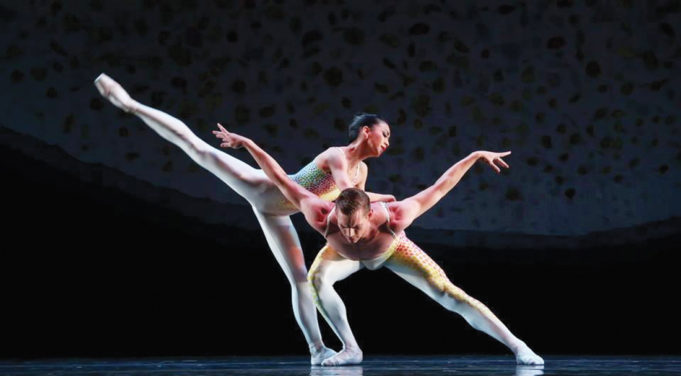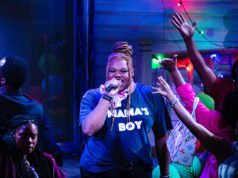Texas Ballet Theater’s ability to perform evening-length classics and contemporary dance pieces with equal ease was brought to mind last weekend when the company presented a trio of modern works in Bass Performance Hall: the world premiere of Val Caniparoli’s Without Borders, the area premiere of Ohad Naharin’s Minus 16, and a revival of Glen Tetly’s 1973 Voluntaries.
An earlier Caniparoli piece, Lambarena, was seen here three years ago, exploring the rhythms and melodies of Africa and the Caribbean in sensual and unique movements. Without Borders is much in the same format, based on the larger geographical area of A Playlist Without Borders, the 2013 album by Yo-Yo Ma and the Silk Road Ensemble. Melodies and rhythms from Asia, the Middle East, and Europe were heard, expanding Caniparoli’s frontiers. The choreography was more balletic this time and more interesting, and it featured a wonderful duet for Leticia Oliveira and Carl Coomer, as well as a smashing athletic solo for Andre Silva on Saturday night.
Black draperies hung upstage, lined along the floor with what looked like large, rectangular paper lanterns but that were actually electric fixtures that could be brightened or dimmed as the mood required.
Minus 16 began halfway through intermission. A young man (Riley Moyano), dressed in a neat black suit and white shirt, came through the center curtain and stood looking out into the auditorium. He stood motionless for at least five minutes. Some thought he was going to make an announcement and paused. When nothing happened, they ignored him. Then his head turned slowly to one side. He repeated the movement to the other, and eventually his body and limbs were all moving in different directions. He looked like a pantomime artist who wasn’t trying to imitate anything, only express something.
The curtain opened on 18 dancers, men and women, all dressed in the same black suits and white shirts, moving in different patterns, some in synch, some on their own. At one point they formed a large, seated semi-circle, responding in movement to soft musical rhythms and melodies. As the movements became more intense, the dancers rose and tore off their jackets. Then their shirts. And finally their trousers. And then they ran off, picking up clothes along the way, before returning later fully dressed. Forming two lines, they marched down stage, down temporary steps, and into the audience to solicit partners to bring onstage. Judging by the shape and age of some of them, these were authentic volunteers, not planted professionals. (One beautiful blonde in a red gown slipped and fell on her behind onstage. Poor thing.)
To the music of “Over the Rainbow” and “Hooray for Hollywood,” the dancers did their own thing, but then they began getting it together with their volunteer partners to form two facing lines. Somehow, synchronized patterns evolved, passing through and around each line as if they all had rehearsed for days.
It was entertaining and fun at times, and the audience seemed to love it, but in truth it wasn’t my favorite ballet.
Interestingly, Voluntaries was first seen here three years ago, on the same program as Lambarena. I don’t know if the accompanying recording then was superfast or what, but I remember that performance as a whirlwind race through Poulenc’s Concerto for Organ, Strings and Timpani and some of the most difficult choreography in ballet. This time it was well paced and handsomely performed.
Alexandra Farber and Jiyan Dai danced the pas de deux with beautiful, gentle lines, and the company handled the tough lifts with apparent ease. Tetley created a number of overhead lifts with variations for the ballerina’s arms and legs once in the air, making the supporting dancer’s job a grueling effort. But everything worked well and made for some of the evening’s best moments.
Missing from the roster was Carolyn Judson, one of TBT’s star performers, who is on maternity leave and may also miss some of next season. We wish her well and hope to see her back soon.











